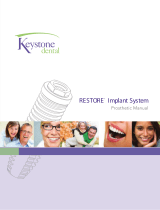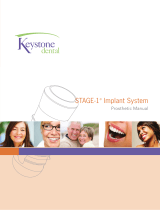Page is loading ...

Impregum
™
Polyether
Impression Materials
Laboratory Handling Guidelines for Polyether Impressions
Control
Please inspect surface quality of the impressions arriving in the lab, (no mushy, melted surfaces).
Surfaces should appear detailed and crisp.
Disinfection
All commercial water-based disinfectants indicated for dental impression materials can be used.
Glutaraldehyde solutions are recommended for disinfection. Follow the manufacturer’s instructions
for use, time, and level of disinfection required. After disinfection, rinse impression well with
water and blow dry. The impression should be kept dry when sent to the laboratory. Temperatures
exceeding 60°C/140°F will damage polyether impressions.
Pouring the Model —Casting
Surfactants (de-bubblizers) are not needed or recommended. Type 3 model stone, type 4 or 5 die
stone can be used to pour polyether impressions. When pouring polyether impressions with epoxy,
or any urethane resin based materials, a separator must be used.
Improved Removal
Heating the impression to about 40°C/104°F after the cast has set will help in the removal of the
cast. Block out, or minimize undercuts if information is not needed. Isolating or blocking out the
palatal area will help in removal of the model on a maxillary impression with a deep vault. When
making a custom tray, make sure that you have 2-3mm material thickness per 1mm undercut. You
may section or cut the custom tray if it is “locked-on” the model.

Implant Impressions
Choosing the right gingival mask material in combination with the right separating material is important:
a) 3M ESPE polyethers (Impregum
™
, Permadyne
™
brands) can be used with common
separators based on silicone, wax, or petrolatum (vaseline).
b) C-silicones (GI-MASK
®
, Coltene
®
) can be used without a separator.
c) Use caution with A-silicones (VPS), they can be used only with a separator that forms a
sealed solid waxy layer (Sherasepal-U
®
, Shera
®
).
Separating materials can be applied with a brush, to insulate areas that are necessary.
Storage
Do not store polyether impressions in sealed plastic bags while still moist. Avoid direct sunlight exposure. Store in a dry place at
room temperature 23°C/73°F. Polyether impressions can be poured anytime within 14 days after it has been taken if stored under
recommended conditions.
Plating
Polyether impressions can be silver-plated, but cannot be copper-plated.
Customer Care Center: 1-800-634-2249 www.3MESPE.com
Dental Products
3M Center
Building 275-2SE-03
St. Paul, MN 55144-1000
USA
3M Canada
Post Office Box 5757
London, Ontario N6A 4T1
Canada
1-800-265-1840 ext. 6229
Printed in USA
© 3M 2007. All rights reserved.
Used under license in Canada.
70-2009-3868-9
3M, ESPE, Impregum and
Permadyne are trademarks
of 3M ESPE or 3M ESPE AG.
Coltene, GI-MASK, Shera and
Sherasepal-U are not trademarks
of 3M or 3M ESPE AG.
Please Recycle
/


